The 5 Most Common Data Subject Access Requests & How to Handle Them Effectively

Summary
You’ll learn how small changes in design, text, timing, and trust can lift your consent rate. You’ll also see how the right tools help you study data and improve your banner with ease.
Data Subject Access Requests (DSARs) are becoming more common every day. Every user wants to know how their personal data is being used & stored. Handling DSARs the right way shows that you value their privacy.
All businesses that store user data must have a proper knowledge of how to manage these requests. As a responsible business owner, it falls upon you to respond to these requests quickly and correctly.
But the thing is, managing DSARs manually can be really tricky. Even if you end up making a single mistake, it can lead to a massive loss of trust. Also, it can eat up a lot of time verifying each and every identity and then responding to them correctly.
So, in this blog, we’ll explain to you how to handle these DSARs efficiently, while focusing on the five most common types of data requests that you can come across.
You’ll also see how the WPLP Compliance Platform can help you manage the entire process easily.
What Are Data Subject Access Requests
Privacy rules have been growing stricter every passing day worldwide.
Now, DSAR should no longer just be an option for you. Every website owner, marketer, or developer should take it into consideration when handling user data.
Understanding DSARs is the first step in building user trust. Let’s start by learning the meaning of DSARs.
A Data Subject Access Request, or DSAR, is a formal request made by any of your website users to access the business data that your business holds about them.
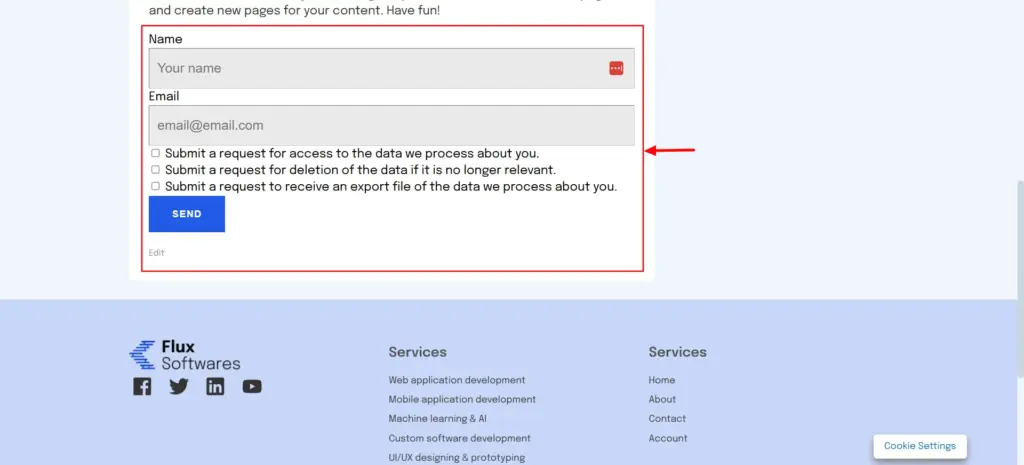
It’s one of the crucial parts of privacy laws like the GDPR in Europe and the CCPA in the USA. These laws give more control to the users over their personal data and ensure that they know how their data is being used.
When any of the users make a data request, their motive on their end would be to update it, delete it, or just plain go through it. This request could include their name, email, purchase history, or even cookies that track their behaviour online.
In simpler words, we can say that DSARs give users rights over their personal information. Doing this will help build trust in the business, as users will know that their information is being handled responsibly.
The 5 Most Common Data Subject Access Requests
In this section, we’ll look at the five most common types of data requests businesses receive and how to manage each one promptly.
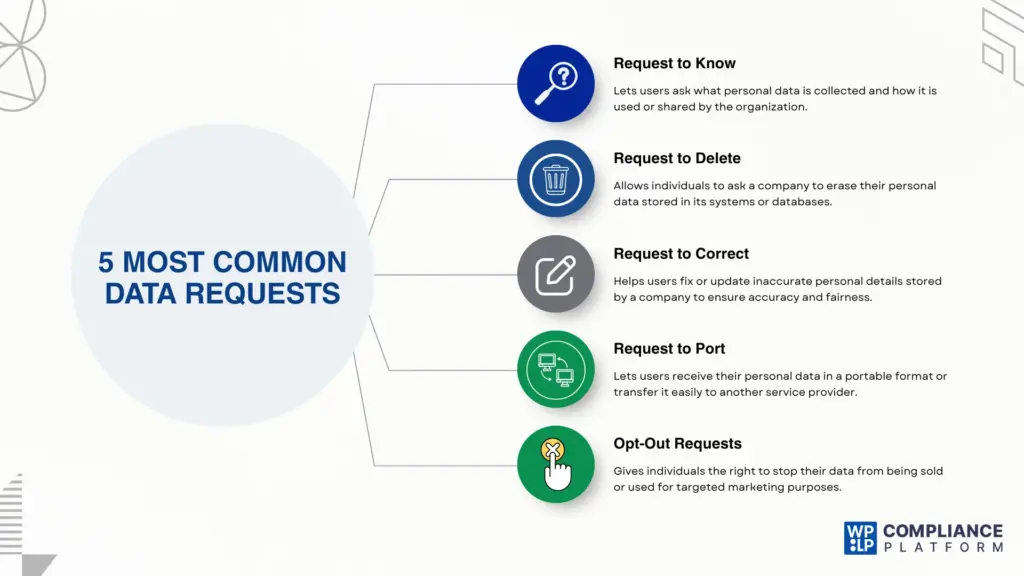
Request to Know
This is the most common type. Request to Know happens when users want to understand what data you’ve collected about them.
They want to know how their personal information is stored, the reason for the collection, and how it’s shared with others.
The user’s motive here is that they want to make sure that their personal information is in safe hands. Nobody wants others to misuse their data.
This type of request helps them know clearly how their information is being used. It’ll help in building their confidence on the website they’re visiting.
And, when you respond to those requests, it’ll show that your business values openness and respects the users’ privacy. Further, it’ll also help in uplifting your brand image.
How to Handle
- When you get a request to know, first and foremost, start by verifying the identity of the person.
- Once verified, gather all data linked to that user across your systems.
- Prepare a clear summary that includes what information is collected, where it’s stored, and who it’s shared with.
- Then, make sure the answer is simple and easy to understand if you’re sending them an email.
- Also, please avoid the technical terms. Don’t make it harder for the user to understand what’s going on with their data.
- Respond within the time allowed by privacy laws. This shows that your business takes user privacy seriously.
Request to Delete
There’s a chance that users may ask to delete their personal data. This means they want all information you’ve collected about them removed from your records.
Users often do this when they no longer use your services or want more privacy.
Data deletion is one of the most crucial user rights under privacy laws. It gives users control over their own data and allows them to manage how it’s used.
Not just that, deleting data also helps your business keep databases organized. It reduces storage costs and lowers the risk of keeping outdated or unnecessary information.
How to Handle
- When you receive this kind of request, verify the person’s identity before deleting anything.
- Next, check if you can legally remove the data.
- Some laws require you to keep certain information (for example, invoices and fraud-prevention logs) for accounting or legal reasons.
- Once everything is clear and good to go, delete the data from all active systems and backups.
- Later, let the user know their data has been removed.
- Also, don’t forget to keep a record that the request was completed.
Request to Correct
Sometimes users may notice that the information that was stored about them is either incorrect or outdated. They totally have the right to fix it.
This is called a request to correct. It ensures your data remains accurate and reliable. This kind of request shows that users are aware of their personal information and want it to stay private.
It’ll also come in handy for you. It’ll help your business maintain the records of user information in a correct way, while avoiding mistakes. Doing this will improve communication and service quality significantly.
How to Handle
- Just like how you did before, first confirm the identity of the person.
- Review the information they want you to edit and correct. If you find errors as mentioned by the user, update the data as soon as possible.
- Inform the user once the correction is complete.
- Keeping accurate data helps your business avoid confusion and maintain users’ trust.
Request to Port
Your website’s users can request a copy of their data in a common format at any time. The reason might be that they’d want to move it to another platform or service. This is known as a request to port.
Data portability gives your users the free hand to share their personal information across different services. It also makes switching between services, websites, or apps easier and more transparent.
For example, a user may ask for their profile, saved contacts, or order history details so they can upload this data to a new account on another website or app.
All the businesses that support data portability show respect for user rights. It also shows that your systems are organized and can handle structured data effectively. Further, building the user trust.
How to Handle
- Again, when handling this request, you should definitely verify who’s making it.
- Then, collect the data related to that user and export it in a structured format such as CSV or JSON.
- Always make sure the file is easy to access and ready to use.
- Deliver it securely so the data stays safe during transfer. This shows users that your business respects their right to data mobility.
Opt-Out Requests
Opt-out requests typically relate to marketing emails, analytics, and advertising cookies. Many users don’t want their data tracked and used for marketing or analytics.
When they send an opt-out request, they’re asking you to stop processing their data for such purposes. This request is quite common, especially for websites using tracking tools.
Opt-out requests help users control their online privacy. They can choose what type of messages or ads they receive and what data is used for analytics.
Honoring opt-out preferences can help in reducing spam complaints and building a cleaner brand image. It’s a simple way to show that your business puts privacy first.
How to Handle
- To handle this request professionally, update the user’s preferences in your system.
- Make sure their choice is respected across all marketing and data tools.
- Later, send a message confirming the update.
- This gives users confidence that their privacy choices are being followed.
Best Practices for Managing DSARs
Before we go into how the WPLP Compliance Platform helps, let’s look at some best practices in the following areas that make DSAR management easier.
- Firstly, create a clear DSAR process. Every business should have a proper process to receive and respond to user requests.
Make the process so easy and seamless that users don’t have to put any thought into the navigation. Only then will they know where and how they can submit their requests.
An ideal flow is a simple form that sends the request to the dashboard, updates the status, and alerts the admin. This ensures the process is smooth. - Always keep the data records updated. Maintain a clear record of where and how you store data. It’ll help you save a lot of time and reduce the chances of errors.
- Try to be as quick as possible when it comes to responding to the data subject access requests of the users. Privacy laws like the GDPR usually ask you to respond within 30 days after receiving the request. This engagement will also help build the user’s trust.
Note: GDPR gives 30 days, CPRA gives 45 days, LGPD gives 15 days, PIPEDA gives 30 days, and so on. These timelines can differ, so keep track of each law and follow the correct deadline. - Make sure your staff understands how to handle DSARs correctly. Train them properly so that they know how to identify requests, verify users, and communicate clearly. A trained team ensures smooth DSAR handling without mistakes.
- Manual DSAR management can be slow and confusing. You can make use of a platform like WPLP, which simplifies everything by automating key steps and keeping you compliant with data privacy laws. Let’s take a look at this in detail in the next section.
How the WPLP Compliance Platform Can Help With DSARs
Managing each and every DSAR manually can eat up a lot of your time. We, the WPLP Compliance Platform, can make this process accurate, organized, and smooth for you. Let’s see how.
Firstly, we help you automate DSAR workflows and keep your data clean & structured, while ensuring you stay compliant with global privacy rules.
With the use of our platform, you can easily handle requests very quickly without any delays. You don’t need to spend hours verifying and collecting data. The platform helps you do it all in just a few clicks.
We also help you maintain a complete record of your data. This’ll make it easy for you to access the information when responding to user requests. Having a structured data inventory also means you can respond with confidence knowing your details are on point.
The main advantage of using our platform is that it helps with privacy policies. You can generate or update your policies so they meet the latest legal standards.
It’s helping you with two things here: one being, no headache of consulting with a professional lawyer; the next being, it’ll keep your business protected & transparent.
Another great feature is audit trails. These logs record how data is handled and what actions are taken. This gives you full accountability and helps show compliance during audits or investigations.
How to Handle Data Requests Using the WPLP Compliance Platform
Now, let’s look at how you can use the WP Cookie Consent plugin inside the WPLP Compliance Platform to manage data requests easily.
First and foremost, you’ll have to install the WP Cookie Consent plugin and open its dashboard.
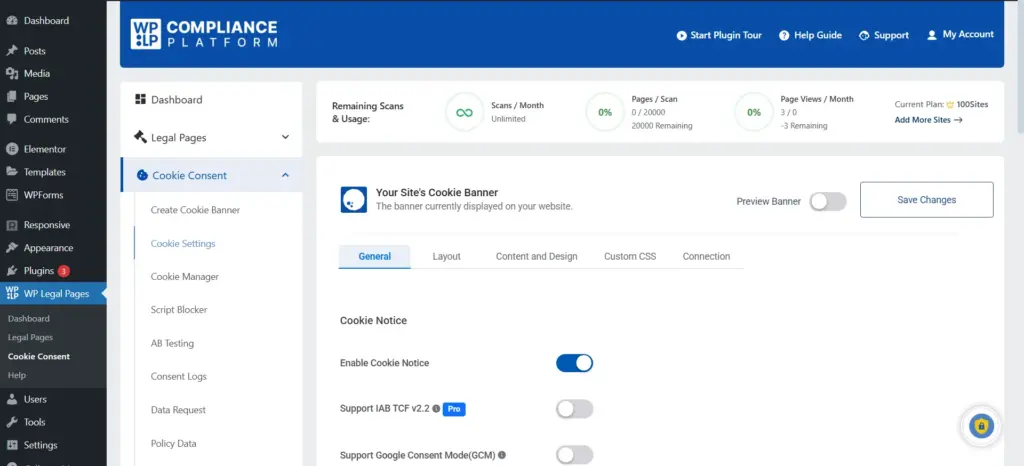
Inside the WP Cookie Consent dashboard, you’ll see the cookie settings section. In that section, you’ll find an option called “Enable Data Request Form.” Simply toggle it on.

Right under that, you’ll find an attribute called “Shortcode for Data Request.” Click on the “Click to Copy” button beside it.
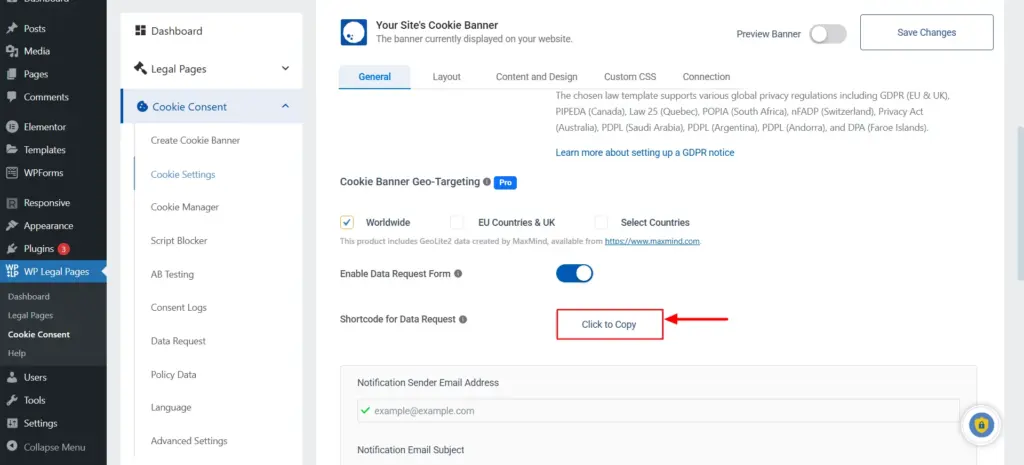
Now, you can paste this code anywhere on your website where you want the data request form to appear. This could be on your privacy page or contact page.

Once users start submitting their requests, you’ll receive them inside the same dashboard. Under the “Data Request” section, you’ll find a simple table that displays all user submissions.
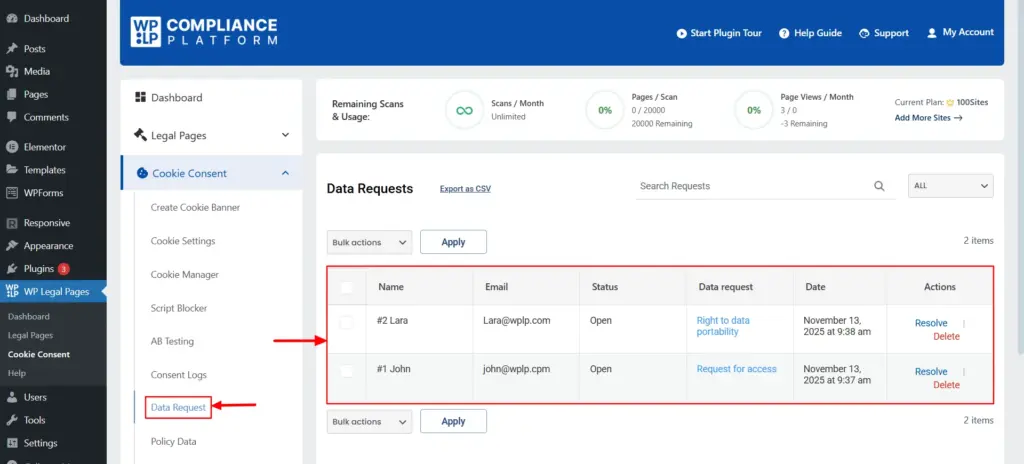
You can review each request and respond directly through the platform. Everything is organized and easy to manage. You don’t need to handle emails or external spreadsheets.
This setup makes the process seamless. You can manage DSARs without extra effort, stay compliant with privacy laws, and build trust with your users.
The WPLP Compliance Platform, with its WP Cookie Consent plugin, truly makes DSAR management effortless and reliable.
Also, make sure not to expose DSAR results publicly. This can cause major security concerns. Try delivering the data securely to the users.
FAQs
It’s a request under the GDPR that allows a user to ask for all personal data a business holds about them. The user can see the purpose of the data use and the places where the data is shared. It helps the user understand how their information is used and stored.
You can refuse a request only in rare cases. This can happen when the request is clearly repeated or when it is made without a valid purpose. You must inform the user about the refusal and explain the reason for the decision in a polite way.
In most cases, you must reply within thirty days. Some laws allow a longer time when the request is complex. You should still inform the user about any delay. But responding on time builds trust and shows that your business takes privacy rules very seriously.
Most requests are free. You may charge a small amount only when the request is repeated or when it needs extra work. The charge must be fair and based on real effort. You must inform the user about any cost before you start processing the request.
No. A user does not need to give any reason at all. They can make a request at any time. You cannot ask for an explanation. You must handle the request in a fair and respectful way, even when no reason is provided.
Conclusion
We’ve unpacked quite a bit today.
- We learned about the meaning of DSAR and why it matters to your business.
- Then, we discussed the five most common types of data requests that businesses typically receive.
- We also looked at how to handle each one in a simple way.
Handling DSARs properly means you earn the trust of your users and show them that you honor their privacy. When people see that their data is safe, they feel confident about your business. And, responding to requests quickly also helps avoid legal issues while keeping your process clean.
The best way to manage these requests is by using the right tools. The WPLP Compliance Platform helps you stay organized and respond on time. We make DSAR management simple and smooth. You can track, respond, and stay compliant without stress.
If you found this blog helpful, you should also take a look at the following.
- From GDPR to AI Regulations: The Future of Data Privacy.
- How to Manage WordPress Privacy With User-Generated Content.
- Understanding Privacy Centers For Better Compliance.
So, take the next step today! Use the WPLP Compliance Platform to simplify privacy compliance for your business.
